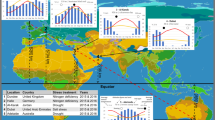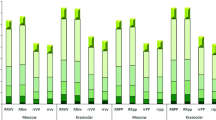Abstract
The adoption of reduced height (Rht) genes has dramatically enhanced yield potential of cereal crops. The semi-dwarfing gene uzu in barley is widely used in East Asia. Its value as an Rht gene in the warm and dry environments in Australia was evaluated in this study. In addition to plant height, this gene showed significant effects on a wide range of characteristics. It reduced the overall plant height by an average of 33.7 % with the most significant reduction occurred on the internode below the peduncle. The gene reduces spike length by 31.6 % and grain weight by 18.8 %. It increases grain number per spike by 5.6 % and grain density by 51.8 %. Seedling assays suggested that the effects of this gene became more significant with increased temperature. It reduced coleoptile and seedling length by 19.4 % and 15.1 %, respectively at 7 °C. The reduction increased to 61 % and 46.7 %, respectively, at 25 °C. These results indicated that the uzu gene could have limited values in some high temperature and drought prone environments.

Similar content being viewed by others
References
Azpiroz R, Wu Y, LoCascio JC, Feldmann KA (1998) An Arabidopsis brassinosteroid-dependent mutant is blocked in cell elongation. Plant Cell 10:219–230
Barua UM, Chalmers KJ, Thomas WT, Hackett CA, Lea V, Jack P, Forster BP, Waugh R, Powell W (1993) Molecular mapping of genes determining height, time to heading, and growth habit in barley (Hordeum vulgare L.). Genome 36:1080–1087
Chen GD, Li HB, Zheng Z, Wei YM, Zheng YL, McIntyre CL, Zhou MX, Liu CJ (2012) Characterization of a QTL affecting spike morphology on the long arm of chromosome 3H in barley (Hordeum vulgare L.) based on near isogenic lines and a NIL-derived population. Theor Appl Genet 125:1385–1392
Chen GD, Yan W, Liu Y, Wei YM, Zhou MX, Zheng Y-L, Manners JM, Liu CJ (2014) The non-gibberellic acid-responsive semi-dwarfing gene uzu affects Fusarium crown rot resistance in barley. BMC Plant Biol 14:22
Chono M, Honda I, Zeniya H, Yoneyama K, Saisho D, Takeda K, Takatsuto S, Hoshino T, Watanabe Y (2003) A semi-dwarf phenotype of barley uzu results from a nucleotide substitution in the gene encoding a putative brassinosteroid receptor. Plant Physiol 133:1209–1219
Chory J, Nagpal P, Peto CA (1991) Phenotypic and genetic analysis of det2, a new mutant that affects light-regulated seedling development in Arabidopsis. Plant Cell 3:445–459
Ellis MH, Rebetzke GJ, Azanza F, Richards RA, Spielmeyer W (2005) Molecular mapping of gibberellin-responsive dwarfing genes in bread wheat. Theor Appl Genet 111:423–430
Foster AE, Thompson AP (1987) Effects of a semi-dwarf gene from Jotun on agronomic and quality traits of barley. In: Yasuda S, Kanishi T (eds) Proceedings of the 5th international barley genetics symposium, 1986. Sanyo, Okayama, pp 979–982
Fujioka S, Yokota T (2003) Biosynthesis and metabolism of brassinosteroids. Annu Rev Plant Biol 54:137–164
Gruszka D, Szarejko I, Maluszynski M (2011) New allele of HvBR1 gene encoding brassinosteroid receptor in barley. J Appl Genet 52:257–268
Hellewell KB, Rasmusson DC, Gallo-Meagher M (2000) Enhancing yield of semidwarf barley. Crop Sci 40:352–358
Hewitt FR, Hough T, O’Neill P, Sasse JM, Williams EG, Rowan KS (1985) Effect of brassinolide and other growth regulators on the germination and growth of pollen tubes of Prunus avium using a multiple hanging drop assay. Aust J Plant Physiol 1:201–211
Kauschmann A, Jessop A, Koncz C, Szekeres M, Willmitzer L, Altmann T (1996) Genetic evidence for an essential role of brassinosteroids in plant development. Plant J 9:701–713
Li J, Chory J (1997) A putative leucine-rich repeat receptor kinase involved in brassinosteroid signal transduction. Cell 90:929–938
Li HB, Chen GD, Yan W (2015) Molecular characterization of barley 3H semi-dwarf genes. PLoS One 10(3):e0120558
Mickelson HR, Rasmusson DC (1994) Genes for short stature in barley. Crop Sci 34:1180–1183
Milach SCK, Federizzi LC (2001) Dwarfing genes in plant improvement. Adv Agron 73:35–63
Powell W, Caligari PDS, Swanston JS, Jinks JL (1985) Genetic investigations into beta-glucan content in barley. Theor Appl Genet 71:461–466
Rasmusson DC (1991) A plant breeder’s experience with ideotype breeding. Field Crop Res 26:191–200
Rebetzke GJ, Richards RA, Fettell NA, Long M, Condon AG, Forrester RI, Botwright TL (2007) Genotypic increases in coleoptile length improves stand establishment, vigour and grain yield of deep-sown wheat. Field Crop Res 100:10–23
Rikiishi K, Saisho D, Takeda K (2008) Uzu, a barley semi-dwarf gene, suppresses plant regeneration in calli derived from immature embryos. Breed Sci 58:149–155
Saisho D, Tanno K, Chono M, Honda I, Kitano H, Takeda K (2004) Spontaneous brassinolide-insensitive barley mutants ‘uzu’ adapted to East Asia. Breed Sci 54:409–416
Szekeres M, Nemeth K, Koncz-Kalman Z, Mathur J, Kauschmann A, Altmann T, Redei GP, Nagy F, Schell J, Koncz C (1996) Brassinosteroids rescue the deficiency of CYP90, a cytochrome P450, controlling cell elongation and de-etiolation in Arabidopsis. Cell 85:171–182
Takahashi T, Gasch A, Nishizawa N, Chua N (1995) The DIMINUTO gene of Arabidopsis is involved in regulating cell elongation. Genes Dev 9:97–107
Takeda K, Takahashi H (1999) Varietal variation for deep-seeding tolerance in barley and wheat. Breed Res 1:1–8
Thomas WTB, Powell W, Swanston JS (1991) The effects of major genes on quantitatively varying characters in barley. 4. The GPert and denso loci and quality characters. Heredity 66:381–389
Tuinstra MR, Ejeta G, Goldsbrough PB (1997) Heterogeneous inbred family (HIF) analysis: a method for developing near-isogenic lines that differ at quantitative trait loci. Theor Appl Genet 95:1005–1011
Wang JM, Yang JM, McNeil DL, Zhou MX (2010) Identification and molecular mapping of a dwarfing gene in barley (Hordeum vulgare L.) and its correlation with other agronomic traits. Euphytica 175:331–342
Zhang J, Zhang W (2003) Tracing sources of dwarfing genes in barley breeding in China. Euphytica 131:285–292
Zheng Z, Wang HB, Chen GD, Yan GJ, Liu CJ (2013) A procedure allowing up to eight generations of wheat and nine generations of barley per annum. Euphytica 191:311–316
Acknowledgments
This publication is based upon work supported by CSIRO (Project R-04818) and the International Science & Cooperation Program of China (No. 2015DFA30600). GC thanks the China Scholarship Council for funding his visit to CSIRO. The authors are also grateful to Caritta Eliasson for her technical assistance.
Author information
Authors and Affiliations
Corresponding author
Ethics declarations
Conflict of interest
The authors declare that they have no conflict of interests.
Additional information
Guangdeng Chen and Haobing Li have contributed equally to this work.
Rights and permissions
About this article
Cite this article
Chen, G., Li, H., Wei, Y. et al. Pleiotropic effects of the semi-dwarfing gene uzu in barley. Euphytica 209, 749–755 (2016). https://doi.org/10.1007/s10681-016-1668-4
Received:
Accepted:
Published:
Issue Date:
DOI: https://doi.org/10.1007/s10681-016-1668-4




